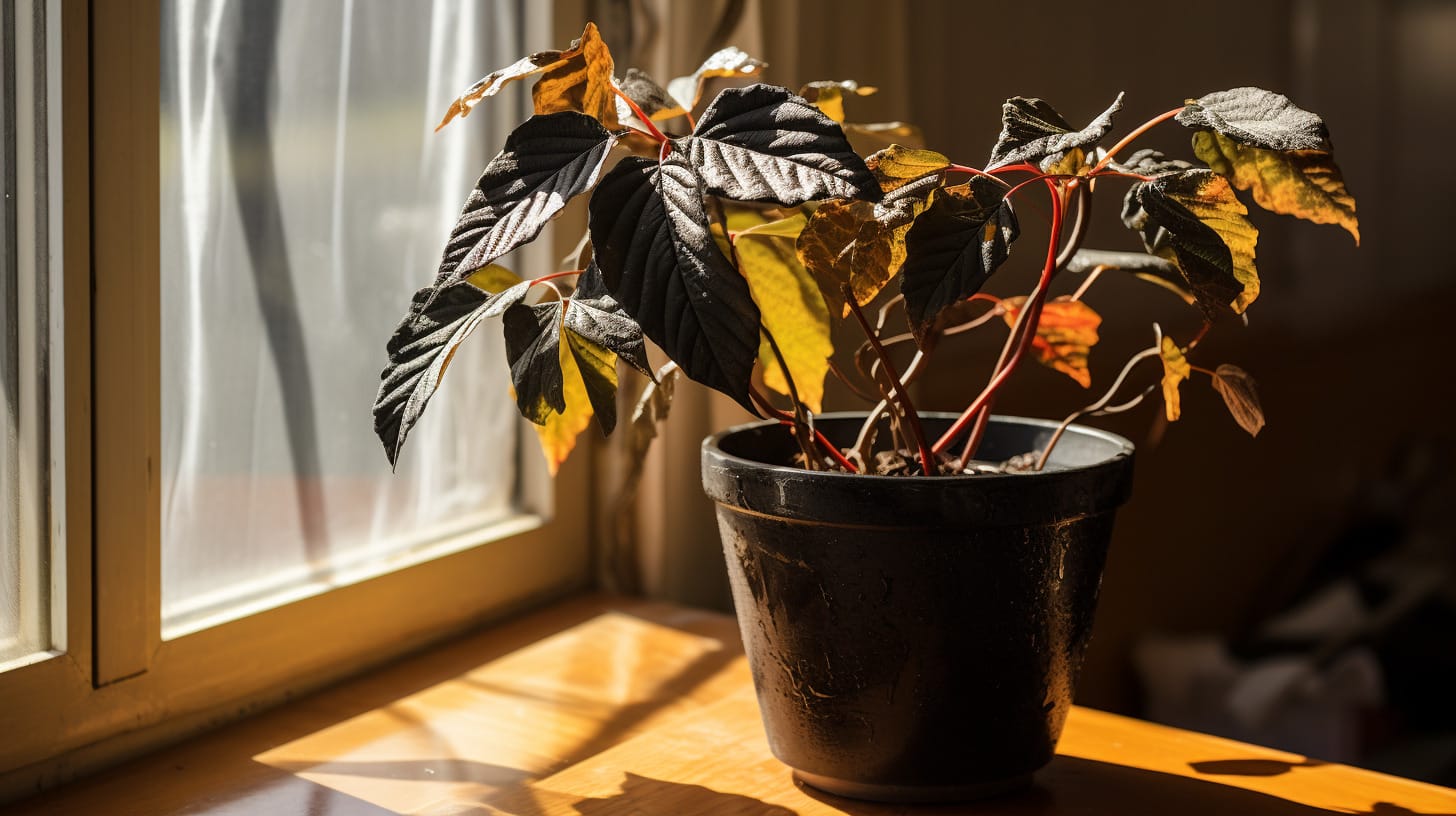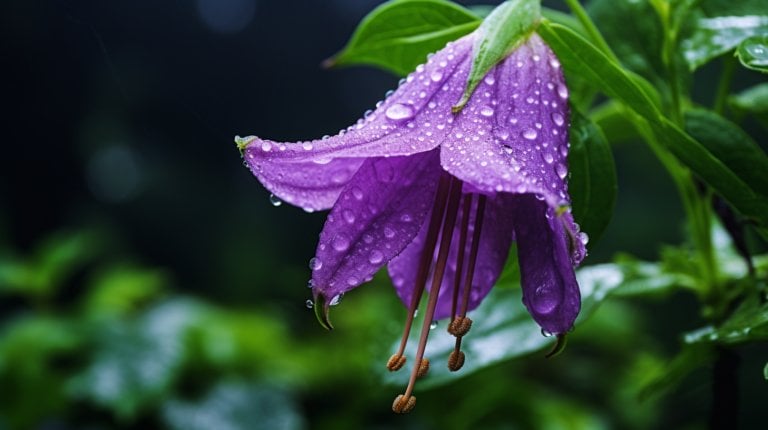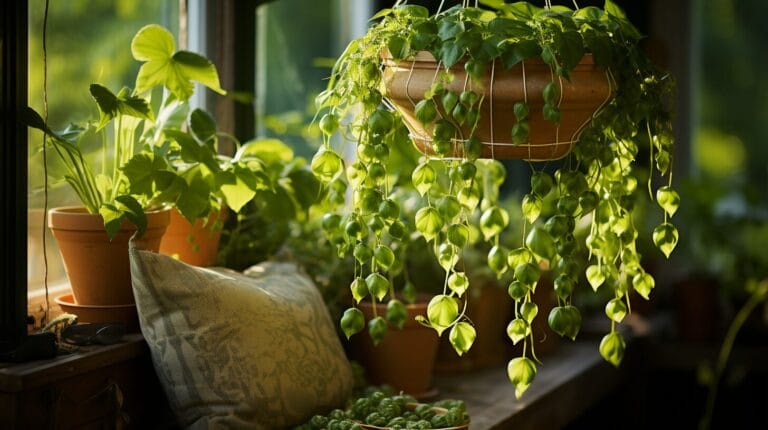Black Leaves On Plants: Unveiling the Hidden Dangers
I genuinely treasure the experience of nurturing plants, amazed by the vast spectrum of leaf hues gifted by Mother Nature. Nevertheless, when the leaves begin to develop a color reminiscent of the nuances of midnight, it garners more than mere intrigue—it provokes worry.
Through my gardening journey, which has taken me through countless cycles of seedling to bloom and back again, I can attest that nothing quite captures one’s attention like the mysterious shift to black foliage.
This disheartening change often waves a red flag signaling that all is not well in our botanical havens. Take overwatering: this well-intentioned gesture can lead to suffocated roots and set off a cascade of rot capable of cutting a plant’s life short.
But fear not—this is merely one piece of the puzzle we’re about to solve together. As we uncover these hidden horticultural truths together, you’ll find your stride in keeping your leafy companions thriving and vibrant.
Key Takeaways
- Black leaves on plants can be a sign of overwatering, root rot, fungal infections or mycosis, pest infestations, nutrient deficiencies or imbalances, and environmental stressors.
- To address blackened leaves, it’s important to diagnose the underlying cause by closely observing signs of overwatering vs. underwatering; identifying fungal damage and pest issues; recognizing nutrient-related blackening; and assessing environmental factors such as sunlight exposure, humidity levels, ventilation, temperature control, and soil quality.
- Proactive measures including appropriate watering techniques, regular monitoring for early detection of issues like pests and fungi along with adjusting environmental conditions will help prevent black leaves on indoor plants and promote overall plant health.
- Understanding the reasons behind black leaves on plants is crucial for maintaining their health. By identifying common culprits such as overwatering or nutrient imbalances early on using actionable strategies like appropriate watering techniques and pest control methods will lead to significant improvements in plant health while enriching your gardening experience.
Unraveling the Mystery: Why Do Plant Leaves Turn Black?
I’ve seen it myself—plant leaves that should be green and vibrant turning a worrying shade of black. It baffles many garden lovers, but there are actually a few reasons why this happens.
Sometimes, if I give my plants too much water, or not enough, their leaves start looking dark and sad. And it’s more than just the wrong amount of water; it can also be because the minerals from the water pile up in the soil or because bugs bring nasty diseases to my beloved greens.
Another thing I keep an eye out for is how much food—I mean fertilizer—I’m giving them. Just like us, plants get sick if they eat too much or not enough of what they need. Getting plant care right means balancing their diet with just enough nutrients without going overboard.
Plus, those creepy crawlies and unwelcome fungi can sneak in and turn healthy leaves into blackened ones before you know it. That’s why I stay alert for any signs of trouble and act fast to keep my leafy friends happy!
Common Culprits Behind Black Leaves on Plants
Overwatering and root rot, fungal infections, pest infestations, nutrient deficiencies and imbalances, and environmental stressors are the common culprits behind black leaves on plants.
Overwatering and Root Rot
I want to tell you about a common mistake many of us make with our plants: giving them too much water. It’s easy to think more water means a happier plant, but that’s not always true.
If we pour on the water too often, the soil gets too wet and doesn’t have enough air pockets. The roots need these air spaces to breathe.
Here’s what happens next—root rot sets in when the roots can’t dry out properly. They start dying off, turning mushy and brown or black. You’ll even smell something rotten around your plant if it has root rot.
And as the roots suffer, so do the leaves. They turn yellow at first then get black spots until they’re all blackened and dead.
To fix this problem, I cut back on watering right away and sometimes move my plant into fresh soil that drains well; for those really bad cases of root rot where nothing else works, I use a fungicide to try and save my green friend from further damage.
It breaks my heart to see plants sick like this because I know how much joy they bring when they’re healthy!
Fungal Infections
Fungal infections are sneaky enemies of plants, often turning leaves black. Warm and damp spots give fungi like powdery mildew, sooty mold, and black spots all they need to grow. I’ve seen how a plant that’s watered too much or doesn’t get enough breeze can easily catch one of these diseases.
And it’s not just about looks; these fungi can really hurt a plant.
To fight back against fungal foes, I use sprays made to kill fungus. It’s important to act fast—once I notice any small black spots or a dusty white coating on leaves, it’s time for action.
Regular check-ups help me spot trouble early so my garden stays healthy and happy. Keeping the air moving around my plants and making sure they get the right amount of sun also makes a big difference in keeping those pesky fungi away!
Pest Infestations
I need to tell you about little critters that can hurt your plants. Bugs like aphids, spider mites, and scale insects are sneaky. They suck the juice from leaves and stems, which makes the plant weak.
These bugs can leave behind sticky stuff called honeydew. This stuff can make a black fungus grow on the leaves called sooty mold.
The bugs themselves might be hard to see, but their damage isn’t. Black spots on your plant’s leaves could mean pests have moved in. I keep an eye out for these troublemakers by checking my plants often.
If I spot them early, I can stop them before they harm my green friends too much.
To fight these pests off without using harsh chemicals, I use things like neem oil or insecticidal soap spray. It’s part of keeping my garden healthy in a way that’s safe for the earth too! And remember to give your plants lots of love – clean up fallen leaves and don’t let water sit around because bugs love that stuff!
Nutrient Deficiencies and Imbalances
Nutrient deficiencies, like not having enough iron or zinc, can lead to chlorosis which is when the leaves turn yellow and then black. Having too little phosphorus usually doesn’t directly cause black leaves, but if there are multiple nutrient problems or an imbalance in nutrients, it can stress the plant and make the leaves go black.
Imbalances in nutrients, such as having too much of one kind or too little of another, can also make the plant’s leaves turn black. This could happen if the soil has very high or very low levels of certain elements that plants need to grow.
Environmental Stressors
Environmental stressors can also contribute to leaves on plants turning black. High or low temperatures can cause stress, resulting in leaf discoloration. Lack of proper sunlight or overexposure to direct sunlight can lead to leaves turning black too.
It’s essential to pay attention to the environmental conditions and make adjustments as needed for the plant’s health. Regular monitoring of temperature, light exposure, and air circulation is crucial for preventing leaves from turning black caused by unfavorable environmental factors.
Ensuring that your plants are placed in optimal conditions according to their specific requirements will help maintain healthy foliage. This involves providing adequate warmth, light, and airflow while protecting them from extreme weather conditions like frost damage or sunburn.
Diagnosing Black Leaf Syndrome

To diagnose black leaf syndrome, closely inspect the affected plant for signs of overwatering, underwatering, fungal damage, pest issues, nutrient-related blackening, and environmental stressors.
Look for symptoms such as wilting or yellowing leaves, the presence of pests or mold on the foliage, and any visible nutrient deficiencies. Regular monitoring and careful observation are key in accurately identifying the underlying cause of leaves on plants turning black.
Signs of Overwatering vs. Underwatering
When your plant’s leaves are turning black, it’s essential to understand whether overwatering or underwatering is the culprit. Here are some signs to help you diagnose the issue:
Overwatering:
- Wilting, yellowing, and eventual browning of lower leaves
- Soil feels consistently damp and waterlogged
- Foul smell emanating from the soil, indicating root rot
- Mold or fungus growth on the soil surface
Underwatering:
- Drooping and browning of leaves, starting from the tips inward
- Dry, crumbly soil that pulls away from the pot’s edges
- Stunted growth and noticeable wilting during the hottest parts of the day
- Brittle, easily breakable stems or leaves
Identifying Fungal Damage and Pest Issues
When it comes to identifying fungal damage and pest issues on your plants, it’s important to carefully observe the symptoms and signs. Here are some key indicators to look out for:
Fungal Damage:
- Look for powdery, fuzzy, or discolored patches on the leaves, which may indicate an infection such as powdery mildew or botrytis cinerea.
- Check for yellowing or browning of the leaves, especially if it occurs in a pattern that follows the veins, as this could be a sign of fungal leaf spot diseases.
- Keep an eye out for wilting, withering, or distorted growth patterns on the plant, which can also be attributed to mycosis affecting the vascular tissues.
Pest Issues:
- Examine the leaves and stems for tiny insects such as whiteflies, aphids, or spider mites, which can often be found congregating around the plant.
- Look for small holes or notches in the leaves caused by chewing pests like caterpillars or beetles.
- Pay attention to any sticky residue or honeydew on the leaves and surrounding surfaces, indicating the presence of sap-sucking pests like scale insects.
Recognizing Nutrient-Related Blackening
I’ve found that the blackening of plant leaves can sometimes be attributed to nutrient deficiencies. Being able to recognize this issue is crucial for maintaining plant health. Here’s how you can identify and address nutrient-related blackening:
- Look for signs of specific nutrient deficiencies such as chlorosis (yellowing) between leaf veins for iron and magnesium, yellowing around the edges of leaves for potassium, and general stunted growth for nitrogen deficiency.
- Conduct a soil test to assess the pH level and nutrient content in the soil, identifying any imbalances or deficiencies that may be causing leaf blackening.
- Check for unusual discoloration patterns on the leaves, which can indicate deficiencies in essential nutrients like phosphorus, potassium, or manganese.
- Observe the overall plant health, including leaf size, color, and density, as well as the rate of new growth to determine if there are any signs of nutrient-related issues affecting the plant.
Assessing Environmental Factors
When assessing environmental factors that can contribute to leaves on plants turning black, it’s crucial to consider the following:
- Sunlight Exposure: Ensure that plants receive adequate sunlight based on their specific requirements. Insufficient or excessive sunlight can lead to leaf discoloration.
- Humidity Levels: Monitor and regulate humidity levels, especially for indoor plants. Proper humidity is essential for the overall health of plants and can prevent leaf issues.
- Ventilation: Adequate airflow around the plants is crucial in preventing fungal infections and maintaining healthy foliage. Stagnant air can contribute to the blackening of the leaves.
- Temperature Control: Maintain suitable temperatures for the plant species. Extreme temperature fluctuations can stress plants and result in leaf damage.
- Soil Quality: Regularly check soil moisture, pH levels, and drainage capacity. Using a well-drained and fertile potting mix is vital in preventing nutrient imbalances that could cause leaves to turn black.
How To Fix Black Leaves On Plants
To prevent leaves on plants from turning black, it’s important to implement proactive measures and treatment strategies. This includes adjusting watering techniques to avoid overwatering, promoting good drainage, and ensuring the plant receives the right amount of water.
Implementing fungal prevention methods, such as proper air circulation and avoiding overhead watering, can also help in preventing leaves from turning black. Additionally, regular monitoring for pest infestations and addressing nutrient deficiencies through appropriate fertilization can contribute to maintaining healthy plant foliage.
Appropriate Watering Techniques
When watering, it’s essential to strike the right balance for healthy plants. Here are some guidelines to help maintain proper watering practices:
- Monitor soil moisture by feeling the top layer – water when it feels dry to the touch.
- Water at the base of the plant to avoid wetting the leaves and causing fungal issues.
- Use a watering can with a spout or a drip irrigation system for controlled and targeted watering.
- Adjust watering frequency based on seasonal changes in temperature and humidity.
- Consider using self-watering containers or adding mulch to retain moisture and reduce the frequency of watering.
Fungal Prevention and Treatment
To prevent and treat fungal infections in plants:
- Maintain good air circulation around plants to reduce humidity, as high humidity can promote fungal growth.
- Remove any diseased or dead plant material from the vicinity to prevent the spread of fungal spores.
- Use preventive fungicidal sprays or treatments on susceptible plants, following label instructions.
- Avoid overwatering and ensure proper drainage to prevent creating a conducive environment for fungal diseases.
- Apply organic fungicides like horticultural oil or neem oil to control certain types of plant fungi without harming beneficial insects and organisms.
Pest Control Methods
Dealing with pest infestations in plants requires diligent and proactive measures. Here are effective pest control methods to maintain plant health and prevent leaves from turning black:
- Regularly inspect plants for signs of pests such as tiny webs, holes in leaves, or sticky residue on foliage.
- Implement natural pest control techniques like introducing beneficial insects or using organic sprays to deter pests.
- Quarantine new plants before introducing them indoors to prevent the spread of potential pests to existing plant populations.
- Keep indoor environments clean and free of debris to reduce hiding spots for pests.
- Remove any affected leaves or plant parts promptly to prevent the spread of pests throughout the garden.
Nutrient Management
To keep your plants healthy, ensuring proper nutrient management is crucial. Here’s how you can maintain optimal soil nutrient levels:
- Regularly test the soil to identify any deficiencies or imbalances in key nutrients like phosphorus.
- Use organic fertilizers to enrich the soil with essential nutrients and promote overall plant health.
- Adjust the pH of the soil using garden lime to create an ideal environment for nutrient absorption.
- Consider adding specific nutrients like phosphorus, which is vital for preventing the blackening of plant leaves.
Adjusting Environmental Conditions
To prevent leaves on plants from turning black, adjusting environmental conditions like watering practices, air circulation, and humidity is crucial. Here are some ways to adjust the growing conditions for plant health:
- Manage Soil Moisture: Monitor the soil moisture levels to ensure proper watering without overwatering or underwatering.
- Sunlight Exposure: Ensure the plants receive adequate sunlight based on their specific light requirements to maintain good leaf health.
- Potting Mix and Fertilizer: Use appropriate potting mix and apply balanced fertilizer to provide essential nutrients for healthy foliage.
- Ventilation and Temperature: Maintain proper air circulation and temperature to create a favorable environment for plant growth.
- Pest and Disease Control: Regularly inspect plants for pests and diseases, taking preventive measures to avoid damage to the leaves.
What Hidden Dangers Can Black Leaves on Plants Indicate?
Black leaves on plants may indicate the presence of brown scale on jade plant. This harmful insect feeds on plant sap, causing leaves to turn black as they wither and die. Quick action is crucial to prevent further damage or infestation spreading to neighboring plants. Regularly inspecting and treating affected plants can effectively combat the brown scale infestation.
The Importance of Regular Monitoring and Plant Care
Regular monitoring and plant care are vital for keeping your plants healthy and preventing leaves from turning black. By observing your plants regularly, you can catch problems early and take action before they become serious.
This includes checking for signs of overwatering, underwatering, pests, diseases, or nutrient imbalances. Providing regular care such as appropriate watering, pest control, and ensuring optimal growing conditions helps to maintain the overall health of your plants.
Additionally, removing affected plants from others is crucial to prevent the spread of disease.
By staying attentive and providing proper care to your plants on a consistent basis you can ensure their well-being and minimize the risk of leaves turning black.
Continue your journey in plant care by exploring the challenges of powdery mildew on jade plants and learn how to protect your green friends from this sneaky menace.
Conclusion
In conclusion, understanding the reasons behind leaves on plants turning black is crucial for maintaining their health. By identifying common culprits like overwatering, fungal infections, pests, and nutrient imbalances early on, one can take proactive measures to ensure plant well-being.
With actionable strategies such as appropriate watering techniques and pest control methods, it’s possible to prevent black leaves and promote healthy growth. Regular monitoring and care play a vital role in nurturing thriving plants.
Applying these practical steps can lead to significant improvements in plant health while enriching your gardening experience.
FAQs
Why do my plant leaves turn black?
Plant leaves can turn black for a number of reasons such as fungus, overwatering, or not enough water. Sometimes they get infected and the disease can make them change color.
Can watering the plant too much be a common cause of black leaves?
Yes, if you water your plants too much, their roots can rot and this will make the leaves turn black or dark brown.
What should I do if my indoor plant leaves are turning black?
First, find out what is causing it—maybe it’s a common disease or your plant needs different care like more light or less water. Then treat your plant based on what it needs to get better.
Are there bugs that can make my plants’ leaves turn black?
Yes, some pests like whiteflies suck on plant juices and cause damage which results in black spots on the leaves.
How does not having enough phosphorus affect my plants?
Phosphorus is important for plants; if they don’t get enough they might show signs like darkening of their leaves because it helps with making food for growth inside the cells.
Can I stop other plants from getting sick when one has black leaves?
You might need to cut off diseased parts or even toss out the whole infected plant to stop sickness from spreading in your garden.







